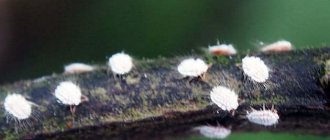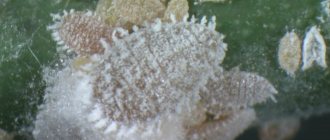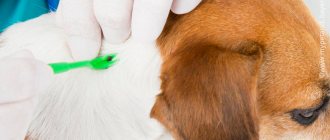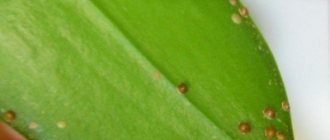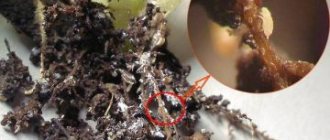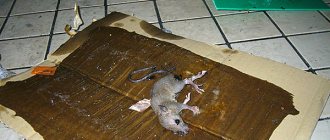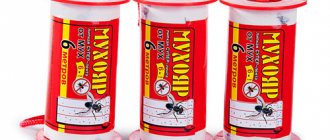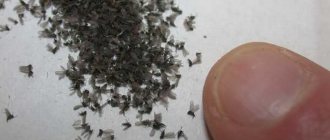Exotic orchids, previously unknown in our country, are increasingly being bred by fans of this flower on their windowsills. Despite the external vulnerability and fragility of the roots, these plants easily adapt to new conditions and tolerate the dry climate of apartments well. However, they are also susceptible to diseases and attacks from harmful insects. The most common one is the mealybug.
There is a lot of information about this pest on the Internet, accompanied by photos and videos. What to do if a mealybug appears on an orchid, how to get rid of it using the most effective methods - find out from this article. It is important to remember that it is impossible to cure a plant from a parasite. You just have to fight it: remove it, destroy it, and then take careful precautions so that it doesn’t appear again.
Signs of the appearance of white plaque on orchid leaves
When a visible white coating appears on the leaves of an orchid, it means that the disease is already progressing with might and main and urgent measures need to be taken to save the flower. The first sign of infection will be a small amount of transparent sticky drops on the leaves, which are easy to miss.
Presence of fungal flora (powdery mildew)
If the orchid is covered with a white coating, similar to a thin layer of flour or talcum powder, and round drops of clear liquid are noticeable on the surface, this is without a doubt powdery mildew. A fungal infection appears on the surface of the leaves in the form of white threads and spots (mycelium). The mycelium then grows into all parts of the plant, sucking out organic and mineral substances.
Also, a variety of molds (white, green, black, etc.) can settle on the orchid. Fungal spores are microscopic in size and can fly far and infect other plants.
White cottony coating (mealybug)
A white coating on the leaves of an orchid, reminiscent of lumps of cotton wool, as well as a large number of white dots on the foliage and peduncle, mean that a mealybug has appeared on the plant.
Female insects are oval in shape and have spines along the edges of their segmented bodies. Their size is 3-6 mm. The color is light, the body seems to be sprinkled with flour. The female's mouthparts are designed for parasitism - she attaches herself to the leaf blade, usually from the underside, and draws out cell sap.
Male mealybugs are smaller in size, with wings, and do not harm plants. Their function is to fertilize females. Parasites multiply rapidly.
Without receiving nutrients, the leaves lose their elasticity and dry out. The buds fall off, new ones are not formed. The growth of the plant slows down, then it dies.
Cotton coating
Mealybug
These parasites are the most dangerous for orchids. They are quite small and look like white dots. If you look at this stage, then a white cotton fiber with some tubercles will appear, which are scales. Another sign of a parasite attack is sticky drops. It is in them that rot develops. The insect is actively developing. The fast colonizes the leaf plate, and then moves to the roots of the orchid, forming the same white coating.
What is the danger of sticky residue?
Any disease weakens the plant, making it susceptible to other infections. For example, a white sticky coating on an orchid caused by scale insects is a favorable breeding ground for the development of sooty fungus (black fungus). Pathogenic fungal microflora clogs the respiratory openings of the leaves, completing the destructive effect of felt insects.
Pests will not stop at one plant; their colonies spread throughout all home flowers, sucking out the juices from them, which ultimately leads to very sad consequences for the home flora.
Lumps and pimples
The tubercles and pimples are mycelium in its infancy. Over time, they will increase in size, burst and spores and mycelia will begin to spread throughout the plant. Opening such blisters is strictly not recommended. It is necessary to immediately cut off the painful leaf.
Such manifestations may indicate the colonization of an adult female pseudoscale insect. Pests feed on juices from tissues and leave a viscous, sticky liquid on them, which creates conditions for the development of rot and fungi.
Reasons for appearance
White plaque, like many other diseases of orchids, appears more often on weakened, ill, or untreated plants. Among other reasons, the main one is errors in the care and maintenance of exotic plants.
Unfavorable conditions of detention
Orchid leaves are more likely to become infected in winter, when they receive little natural sunlight. This condition is aggravated by:
- excessive watering;
- low temperature (for example, when a window sill freezes);
- excessive mineral fertilizing (especially potassium, nitrogen, phosphorus-containing fertilizers).
Excessive watering
Putrefactive processes due to waterlogging of the substrate
As a result of constant watering, the soil becomes acidic and organic matter begins to rot. The plant does not receive nutrition from the roots, the leaves lose their protective properties and are susceptible to fungal and other diseases.
As a result of infection, a white sticky coating appears on the leaves.
Infected soil
Another reason why plaque appears on the leaves is incorrectly selected soil for orchids. The basis of the soil mixture for tropical guests is tree bark. If stored or handled improperly, pathogenic microorganisms and insects may develop in it.
Dead parts of the plant that were not removed in time
Clogging the pot with organic debris provokes the appearance of pests, which in turn are a source of sticky plaque on the plant.
Failure to comply with temperature conditions
It is difficult to protect yourself from mold if:
- large jumps in room temperature, sudden changes between day and night temperatures;
- too low (below +15°C) or high (from +30°C) temperature;
- the danger increases in combination with high air humidity (more than 80%).
Other reasons
Other reasons why orchids become covered with a white coating include the presence of pests such as:
- aphid;
- spider mites;
- Scale insects.
What if the cause of the problem is not disease or pests?
First of all, it is recommended to examine the orchid and make sure that the cause of the dew is not due to parasites or diseases. If diseases and parasites were not detected, then the flower should be treated in the following way:
- During the formation of nectar . Remove the sticky surface using a dampened cotton pad. Wipe the leaves thoroughly and remove any sticky surface. It is also recommended to reduce the number of water treatments.
- Overflow. If the plant's leaves become sticky or spots have formed, you should dry the top layer of soil in the pot and ensure good drainage.
- Excess fertilizer. The best way to get rid of this disease is to change the soil in the pot to prevent death and rotting of the peduncle.
Which orchids are most susceptible to disease?
Plant growers note a tendency to diseases in the following types of orchids:
- Phalaenopsis orchids. Their numerous hybrids are sold everywhere; not all of them have passed laboratory tests and can be considered resistant to fungal infections and parasitic insects.
- Vanda orchids. The royal orchid, with its large, attractive, rounded flowers, often suffers in home conditions that differ from those created for growing them in nurseries.
- The Cattleya orchid is famous for its delicate aroma and elegant velvety petals with wavy edges. It is also considered among flower growers to be a rather capricious creature, requiring a special approach and content.
Wanda
Agrotechnical measures
During the same period, spraying with one or another medicinal preparation is carried out.
All diseased leaves are torn off. Most often, they prematurely acquire a yellow color and stop turgor. At the same time, they also get rid of the flower stalks. If a bush orchid is being cultivated, severe pruning is recommended. The more infected vegetative mass of plantings is removed, the higher the chance that the plant will be successfully cured. All trimmed parts of the plant must be destroyed.
The upper soil layers are densely populated with numerous colonies of fungal mycelium. Therefore, it is replaced in flower beds, pots and containers. If possible, it is recommended to replace all the soil completely.
It is necessary to generously moisten the entire above-ground plant part of the plants with special preparations. Spraying should be such that the plant drips as if it had just been exposed to heavy rain. A more effective way to treat an orchid is to pour a solution of the medicinal drug into a basin and place the plant there. The soil mixture is also processed. It is carried out by irrigation or using a spray bottle. It is also necessary to apply the preparation to pot walls, trays and other surfaces with which the plant or soil comes into contact during cultivation.
How to treat a plant?
The choice of method for treating white plaque on orchids depends on correctly determining the cause of its formation.
First of all, the diseased plant must be isolated from the rest to prevent the spread of infection (quarantine). The soil must be thrown away, replaced with fresh one, and the plant itself must be properly processed.
Treatment methods for fungal diseases
Fungal diseases of orchids, such as white mold and powdery mildew, can be treated with fungicidal (antifungal) drugs. What exactly needs to be done and how to process it in order to successfully fight the infection, the manufacturer indicates in the instructions for the drug.
- Fundazol is a systemic fungicide if used for irrigation. In case of spraying, it does not have a systemic effect, only local.
- Quadris is used for spraying.
- Trichodermin, Mikosan, Fitoverm, Alirin are preparations of biological origin that can also be used for prevention.
How to treat for parasites?
To get rid of sucking insects that cause white plaque on orchids, insecticides of chemical and microbiological origin are used. Popular drugs that can be used to treat plants at home:
- Aktara, when watered, has a systemic insecticidal effect, that is, it rises through the capillaries to all parts of the flower. During spraying, toxins penetrate into the pulp of the leaf. The parasite receives a portion of the poison and dies when it sucks out the plant sap.
- Actellik, Decis, Karate and Inta-Vir are enteric contact poisons; they are sprayed onto the plant. If the insect colony is not large, one treatment will be sufficient.
- Fitoverm and Agravertin (biological products) can be treated (sprayed) orchids with a break of 1-2 weeks.
Attention! When working with pesticides, you should remember that they are poisons and allergens for humans; you must follow the precautions specified by the manufacturer.
Aktara
What to do with whiteheads?
As a rule, white spots on orchid leaves that appear simultaneously with plaque do not require special treatment. They will disappear on their own after the cause (disease) is eliminated.
Fighting methods
If signs of mealybug activity are detected:
- The flower is isolated from other plants;
- Carry out mechanical cleaning - remove all ovaries and flowers, as well as infected leaves, treat hard-to-reach areas with a cotton swab or wash the plant under running warm water;
- Severely affected foliage is removed;
- The orchid is provided with comfortable conditions , the temperature and humidity are raised;
- The window sill and objects next to the diseased flower are wiped, since they may also contain pests.
At the final stage, the orchid is treated using folk remedies or insecticides.
Folk remedies
These methods are suitable in the early stages of orchid infection:
- Soap-alcohol solution - add crushed soap (a teaspoon) and two tablespoons of alcohol or 4 tablespoons of vodka to one liter of water. Wipe the leaves, stems and leaf axils with the prepared product, carefully treat the inside of the leaf;
- Two cloves of garlic are crushed and diluted in a liter of water. The orchid is sprayed with the resulting composition and kept under a plastic bag for 24 hours;
- The plant is wiped with an infusion of calendula in alcohol or an aqueous tincture of tobacco.
The flower is treated every 3-4 days until the pest completely disappears. To increase the effectiveness of treatment, it is advisable to alternate home remedies.
Chemical and biological products
Among the biological products is Fitosporin . Spraying is carried out 2-3 times with an interval of seven days. If the remedy does not help, you will have to turn to chemistry.
Attention! Insecticides are used only in the most advanced cases, when wiping and home treatments do not help.
An adult mealybug is covered with a waxy layer, so contact drugs have little effect on it.
When the orchid is in a neglected state, various preparations should be used.
To destroy them, it is better to use systemic insecticides :
- Aktara;
- Angio;
- Confidor Maxi;
- Calypso.
They are used in the form of a solution for spraying plants, diluting the product according to the instructions . Since the active substance does not affect insect eggs, re-treatment is carried out 3-4 times with an interval of 10-14 days.
Features of the use of chemistry
When working with insecticides, strict adherence to safety rules :
- Work with chemicals is carried out with gloves and a respirator;
- After finishing the work, the tools are washed and stored in a special place;
- In case of contact with skin, the insecticide is washed off with water and detergents. If the product gets into the eyes, rinse with running water;
- It is prohibited to eat or drink while carrying out work.
If you follow the instructions for the drug, it does not have a harmful effect on the orchid.
Prevention measures
To prevent the appearance of white plaque on orchids, experts recommend following the following rules of care:
- Watering mode. Tropical flowers should be watered only after the soil has completely dried out. The pots are placed in a tray with settled water at room temperature and removed when the substrate is completely moistened.
- The temperature in the warm season should be : 20-25 °C during the day, 15-18 °C at night. In the cold season, it is better to provide the plants with rest and keep them at a temperature no higher than 15-16 °C.
- Lighting is an important factor in the prevention of any diseases. There are varieties of orchids that are more light-loving and shade-tolerant. When purchasing, you should pay attention to the conditions in which the flowers are kept. In any case, 12 hours of daylight without direct sunlight is optimal.
- Humidity within 55-75%. Orchids should be sprayed periodically (in a shaded place).
- Soil for orchids must be balanced , clean, and from proven sources.
Main mistakes during treatment
When trying to save an orchid from white plaque or white mold, inexperienced gardeners may make some mistakes that should be avoided :
- Creating high humidity in a room with a diseased plant;
- Placing the diseased plant in direct sunlight to dry the soil;
- Use of large doses of chemicals.
ADVICE! When treating a sick orchid, the first rule is not to overdo it with measures and doses. This will help avoid chemical and sunburn and other unforeseen troubles.
